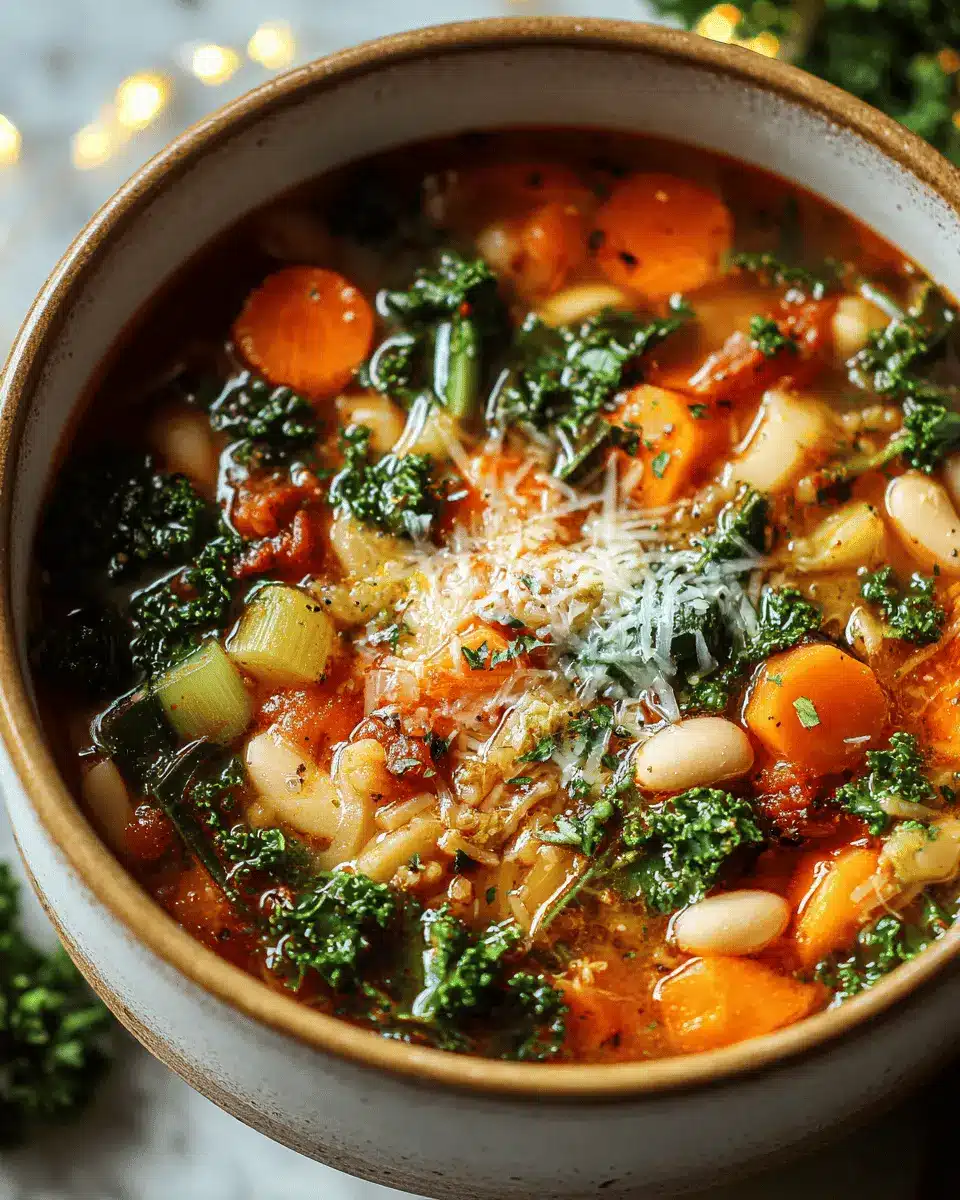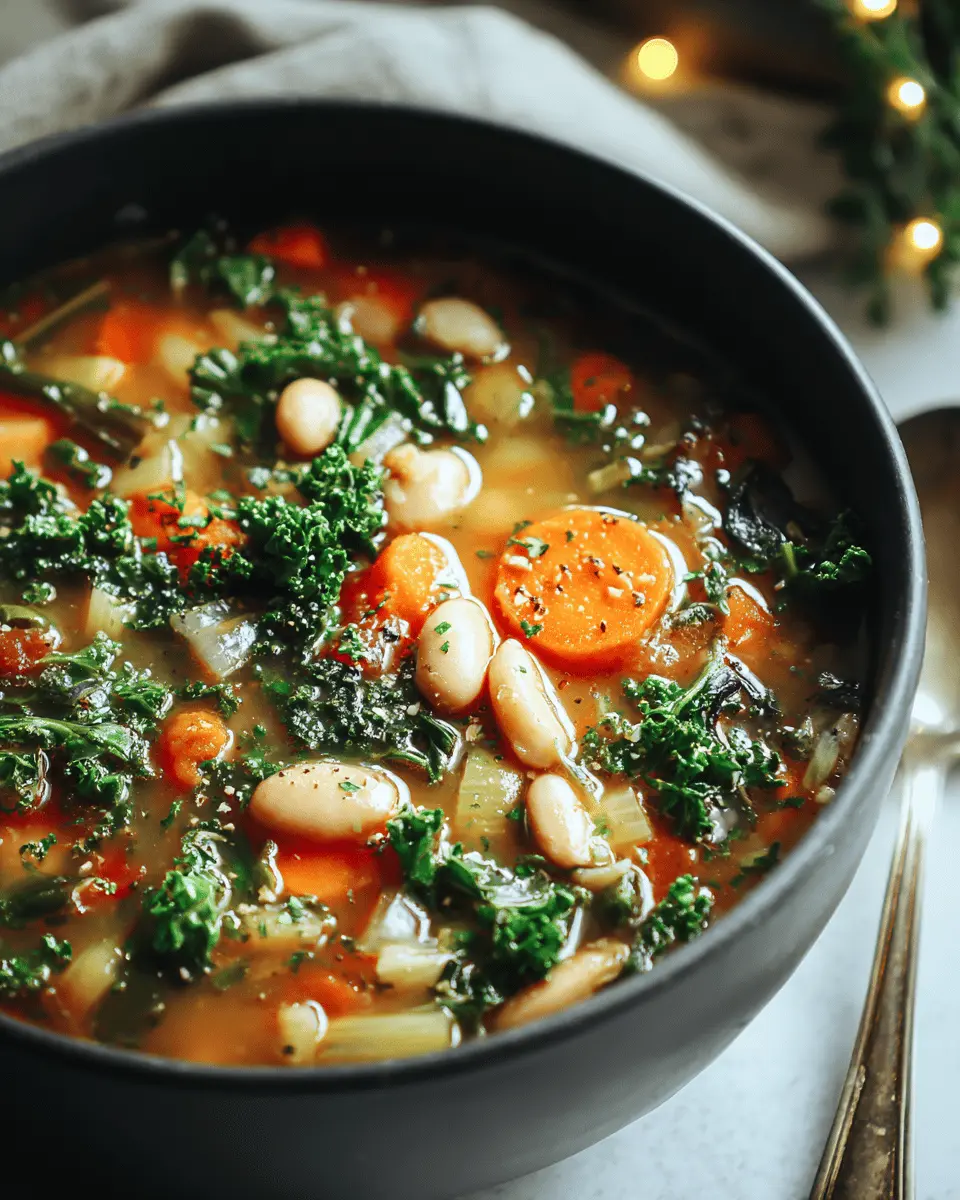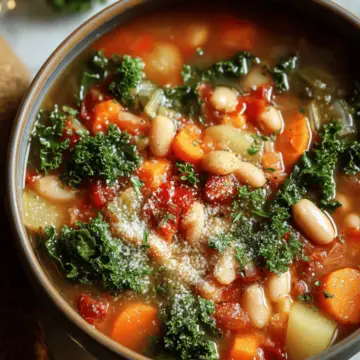Introduction to Winter Minestrone Soup
As the days grow shorter and the chill of winter sets in, there's nothing quite like warming up with a hearty bowl of soup. That’s where Winter Minestrone Soup comes into play. This rustic dish is not only delicious but is teeming with nutritious vegetables and wholesome ingredients that comfort both body and soul.
Why Choose Homemade Soup for Winter?
Making your soup at home offers numerous benefits. First off, it allows you to control the ingredients, ensuring that you're using the freshest produce and wholesome, natural flavors. Using seasonal veggies like kale, carrots, and celery not only makes your soup taste better but also maximizes nutritional benefits. According to health experts, homemade soups can be a great source of hydration and nutrients, essential for maintaining energy levels during winter months.
Plus, there’s an immense joy in cooking from scratch! It’s a great way to express creativity — experiment with different spices or add in some local favorites. So why not cozy up in your kitchen, stir up a pot of Winter Minestrone Soup, and enjoy the delightful aromas wafting through your home? If you're ready to dive into this delightful experience, keep reading for the full recipe!

Ingredients for Winter Minestrone Soup
Fresh veggies for flavor
The heart of any satisfying Winter Minestrone Soup lies in its robust selection of fresh veggies. Start with:
- Onion: Adds a sweet and savory backdrop.
- Carrots: Bring a touch of natural sweetness and bright color.
- Celery: This adds a lovely crunch and enhances the overall flavor profile.
- Garlic: A must for that aromatic kick.
- Kale: Not just a trend—this hearty green adds nutrition and texture.
Together, these ingredients create a deliciously nourishing base for your soup.
Essential pantry staples
Next up are the pantry staples that make this recipe easy and accessible. Grab:
- Canned diced tomatoes: For a rich, tangy essence.
- Vegetable broth: Infuses the soup with deep flavors.
- Cannellini beans: They add protein and creaminess.
- Small pasta: Think ditalini or whatever you have on hand.
- Italian seasoning, salt, and pepper: Perfect for that essential flavor boost.
Together, these ingredients transform simple veggies into a warming bowl of Winter Minestrone Soup. For a different spin, check out more about the health benefits of kale from resources like Healthline or Medical News Today. Cooking doesn’t have to be complicated, and this simple combination will keep you cozy all winter long!
Step-by-step preparation of Winter Minestrone Soup
Creating a warming bowl of Winter Minestrone Soup is easier than you might think! This comforting dish is perfect for chilly evenings and can be made in just a few simple steps. Let’s dive into the preparation, shall we?
Sauté the aromatics
To kick things off, grab a large pot and heat up a tablespoon of olive oil over medium heat. Once the oil shimmers, it’s time to bring in the flavor! Add in your chopped onion, diced carrots, and celery. These aromatic vegetables are the foundation of your soup—being low in calories but high in nutrients, they’ll pack a flavorful punch. Cook everything for about 5-7 minutes until they soften and the kitchen starts smelling delightful. Don’t forget to add in the minced garlic during the last minute to avoid burning!
Add the main ingredients
Next, it’s time to transform your base into a nourishing Winter Minestrone Soup! Stir in a can of diced tomatoes, the vegetable broth (about 4 cups), and the cannellini beans. These beans not only add creaminess but also increase the protein content, making this soup even more satisfying. Toss in that cup of small pasta—like ditalini—which will absorb the soup's flavors beautifully. Finally, fold in your chopped kale and sprinkle in Italian seasoning for that classic minestrone taste.
Bring to a boil
Once all the ingredients are in, crank up the heat and bring your concoction to a rolling boil. It’s important to reach this stage because it ensures that the pasta cooks evenly. A gentle reminder: this is the stage where your soup starts to exude its rich aroma, enticing everyone nearby!
Simmer until perfect
After the soup reaches a boil, it’s time to reduce the heat. Allow your minestrone to simmer uncovered for about 20 minutes. This is when the flavors meld together, and the ingredients cook down to create that hearty, comforting texture we all love. Keep an eye on the pasta; it should be tender yet firm to the bite.
Adjust seasoning
Once the simmering is complete, taste your glorious Winter Minestrone Soup. This is the moment to adjust the seasoning—add salt and pepper to your liking. A pinch of additional Italian seasoning could also elevate the flavor profile. Remember, you want a balance that resonates with your taste buds.
Serving this soup on cold days brings a sense of coziness you won’t want to miss. Pair it with some crusty bread or a sprinkle of parmesan cheese, and you have a meal that nourishes both body and soul! For more tips on ingredient swaps or cooking techniques, check out sources like The Kitchn for inspiration. Enjoy your cooking adventure!

Variations on Winter Minestrone Soup
Winter Minestrone with Turkey Bacon
If you’re looking to add a savory twist to your classic Winter Minestrone Soup, try incorporating turkey bacon. Its rich, smoky flavor enhances the soup brilliantly, giving it a heartier essence. Simply crisp up the turkey bacon in the pot before adding your vegetables. Not only does this variation bring depth, but it also appeals to those craving a meaty touch without the guilt of traditional bacon. Just be mindful of the sodium levels; you might want to adjust the seasoning accordingly!
Vegan-friendly Minestrone
For a completely plant-based option, you can craft a vegan-friendly minestrone that skips the meat altogether. Use vegetable broth and replace the cannellini beans with lentils for an added protein boost. To give it a zesty note, try adding a splash of lemon juice or some fresh herbs like basil or parsley. This version retains all the comforting elements of your favorite Winter Minestrone Soup, making it a nourishing choice that even meat lovers will enjoy. For more tips on plant-based meals, check out this guide on vegan cooking!
Whichever variation you choose, you’ll have a warm and delicious bowl ready to chase away the winter chill.
Cooking tips and notes for Winter Minestrone Soup
Best practices for ingredient prep
When preparing your Winter Minestrone Soup, take a little time to chop your veggies uniformly. This ensures even cooking and a pleasing texture. For instance, dice your carrots and celery into similar-sized pieces. If you're feeling adventurous, switch up the vegetables based on what’s in season—like adding zucchini or sweet potatoes. For convenience, you might consider prepping your ingredients the night before; it makes for a smoother cooking experience!
Storing and reheating tips
If you find yourself with leftovers, Winter Minestrone Soup stores beautifully! Keep it in an airtight container in the fridge for up to five days. When you're ready to enjoy, gently reheat on the stovetop over low heat, adding a splash of vegetable broth if it’s thickened up too much. You can also freeze it for up to three months. Just remember to leave some space in the container for expansion!
For more tips on ingredient storage, check out this helpful guide.

Serving suggestions for Winter Minestrone Soup
Ideal pairings for a cozy meal
When you're cozying up with a bowl of Winter Minestrone Soup, think about pairing it with some crusty bread or a light side salad. A warm, artisanal baguette soaked in the savory broth is a classic choice, while a crisp arugula salad topped with lemon vinaigrette can add a refreshing contrast. Try serving it alongside a hot cup of herbal tea or a homemade fruit-infused beverage for a wholesome, comforting experience.
Creative ways to serve
Elevate your Winter Minestrone Soup by adding a dollop of creamy pesto or a sprinkle of freshly grated Parmesan on top. You can also serve it in individual bread bowls for a fun twist! If you're feeling adventurous, toss in some spicy croutons for added crunch. Don't forget to garnish with fresh herbs, like basil or parsley. For a heartier meal, consider adding slices of turkey bacon or chicken ham on the side—layering flavors will make your dish unforgettable!
For more serving ideas, visit The Kitchn and EatingWell.
Time Breakdown for Winter Minestrone Soup
Preparation Time
The prep work for this Winter Minestrone Soup is a breeze and takes about 15 minutes. You’ll chop the vegetables, measure out your ingredients, and have everything ready to go!
Cooking Time
Once your ingredients are prepared, the cooking process will take roughly 30 minutes. This includes sautéing the veggies and allowing the flavors to meld as the soup simmers.
Total Time
In total, you'll be enjoying a warm, comforting bowl of Winter Minestrone Soup in about 45 minutes. Perfect for a quick weeknight dinner or a cozy weekend lunch!
For more tips on meal prep and timing, I recommend checking out resources from Cooking Light for great advice on efficiency in the kitchen!
Nutritional Facts for Winter Minestrone Soup
When it comes to cozy cooking, Winter Minestrone Soup is a delightful, hearty option that’s not only delicious, but also packed with nutrients. Let’s break down its nutritional profile a bit further:
Calories Per Serving
Each bowl of Winter Minestrone Soup contains approximately 180 calories, making it a low-calorie option for a satisfying meal. It’s perfect for those cold nights when you want something warm without the guilt.
Protein Content
With a healthy mix of beans and vegetables, this soup offers around 9 grams of protein per serving. Protein is essential for maintaining energy levels and supporting muscle health, especially for those leading an active lifestyle.
Fiber and Sodium Levels
This recipe is rich in fiber, with about 7 grams per serving. A fiber-rich diet can help improve digestion and keep you feeling full longer. As for sodium, the Winter Minestrone Soup can range from 400 to 600 mg, depending on the broth used. For a lower sodium option, opt for a low-sodium vegetable broth to keep your meal heart-healthy.
For more on the benefits of fiber, check out this article from the Harvard T.H. Chan School of Public Health.
Incorporating Winter Minestrone Soup into your meal rotation not only warms you up but also nourishes you from the inside out. So grab your pot and enjoy a bowl of wholesome goodness!
FAQs about Winter Minestrone Soup
Can I add different vegetables?
Absolutely! One of the best aspects of Winter Minestrone Soup is its versatility. Feel free to throw in seasonal veggies like butternut squash, zucchini, or even parsnips for added flavor and nutrition. If you have leftover veggies in your fridge, they can make a great addition too!
What can I substitute for pasta?
If you're looking to make your Winter Minestrone Soup gluten-free or simply want to switch things up, consider alternatives like quinoa or even spiralized zucchini. Both options provide a tasty twist while ensuring your soup remains hearty and fulfilling.
How do I store leftovers?
Leftover Winter Minestrone Soup can last in the refrigerator for about 3-4 days. Store it in an airtight container for the best flavor. For longer storage, freeze it in portion-sized containers; it can last up to 3 months in the freezer. Thaw overnight and reheat when you're ready for a cozy meal!
For more tips on optimizing your soup experience, check out resources like The Kitchen and Food Network.
Conclusion on Winter Minestrone Soup
Embracing comfort in a bowl
Winter Minestrone Soup is more than just a meal; it’s a warm embrace on a chilly day. With its hearty ingredients and vibrant flavors, this soup not only nourishes the body but also lifts the spirit. Enjoy it solo or with friends for an inviting dining experience. Remember, it can be customized to fit your taste!
For more delicious soup ideas, check out this resource on nutritious soups and start your culinary adventure today!

Winter Minestrone Soup: Easy, Hearty Recipe with Turkey Bacon and Chicken Ham
Equipment
- large pot
Ingredients
- 1 tablespoon olive oil
- 1 onion, chopped
- 2 carrots, diced
- 2 celery stalks, diced
- 2 cloves garlic, minced
- 1 can (15 oz) diced tomatoes
- 4 cups vegetable broth
- 1 can (15 oz) cannellini beans, rinsed
- 1 cup small pasta (like ditalini)
- 2 cups kale, chopped
- 1 teaspoon Italian seasoning
- Salt and pepper to taste
Instructions
- In a large pot, heat olive oil over medium heat. Add onion, carrots, celery, and garlic; sauté until softened.
- Stir in tomatoes, broth, beans, pasta, kale, Italian seasoning, salt, and pepper.
- Bring to a boil, then reduce heat and simmer for 20 minutes, or until pasta is tender.





Leave a Reply